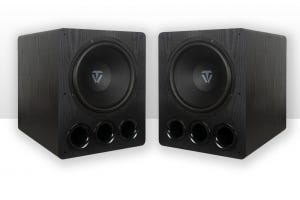
As with any home speaker system, there can be benefits to adding a subwoofer to a PA system. A subwoofer is a speaker specifically designed to reproduce low frequencies, typically ranging from 30 Hz to 150 Hz. Standard PA speakers can reproduce a wide range of frequencies, but just as with classic bookshelf or floorstanding speakers, they can be augmented with a subwoofer.
Typically, full-range loudspeakers can produce frequencies as low as 60 Hz. This is plenty of range for small rooms or low-volume applications. However, frequencies on the low end won't get as loud when playing at higher volumes. Adding a sub to any speaker system helps to emphasize bass frequencies to give the sound more body and weight. This is especially important when using PA speakers for DJ sets or mixing live bands -- the addition of a subwoofer can add volume and deliver that booming bass that makes the audience move.
Integrating a Sub into Your System
As you may know, subwoofers are either active or passive. Passive subwoofers require a power amplifier to work, and active subwoofers have an amplifier built-in. Make sure you have an amp that will work with a sub unless you plan on getting an active subwoofer.
Additionally, in order to integrate a subwoofer, you need a PA system that has a crossover. A crossover simply routes different frequencies to different speakers in the system. All frequencies above a set point (the crossover point) are sent to the full range loudspeakers, and all lower frequencies are sent to the subwoofer. Luckily, most modern speakers nowadays have built-in crossovers, and you may not even have to set the crossover point.
In terms of connections, adding a sub to your system should also be pretty straightforward. The best cabling route may differ depending on your setup, but you most likely will want to wire the signal through the subwoofer and into the loudspeakers. In other words, you can connect the output of your mixer to the input of the subwoofer, and the output of the sub to the inputs on the speakers.
Alternatively, you can send a post-fader aux channel on your mixer directly to the subwoofer, rather than feeding the main outputs through the sub. In this case, you would connect your main channel outputs to your loudspeakers as usual, and connect an aux send output to the subwoofer. This type of setup can be beneficial because it allows you to control which frequencies are sent to the subwoofer in the first place. For example, in a live band setting, you might capture unwanted low frequencies through the microphone, from handling noise or other sounds in the room. If all channel output is sent to the subwoofer, the sub will reproduce these frequencies and the audience may hear thumping. With an aux send, you can limit the channels sent to the subwoofer to avoid issues like these.
Filtering
To ensure a smooth transition and integration of the frequencies from sub to loudspeaker, filtering is important. Along with crossover, some subwoofers have built in filtering options. You may see a "through" and "high pass filter" or HPF switch on the back of the subwoofer. This tells the sub which frequencies to send through the output. If your sub was connected to another sub, and you wanted to send the entire audio signal through, you would set it to "through". If you want to send only the high frequencies, or the frequencies above the crossover point, to the loudspeakers, you would turn on the high pass filter.
Using a high pass filter is beneficial for a number of reasons. Firstly, it can save energy and power in your loudspeakers. Since the PA speakers don't need to produce the low frequencies, filtering them out conserves power and makes it more available for the upper range. Limiting the PA speakers to a smaller range of frequencies also reduces Intermodulation Distortion, or IMD, which is a type of distortion caused by a wide range of frequencies coming out of the same speaker.
More Control
You may or may not see additional controls and settings on your subwoofer. Any additional controls will allow you to further fine tune your system response. Most subs have a "level" knob that adjusts the output level of the sub so you can align it with the speakers or customize it based on the environment. Since subwoofers aren't as directional as typical speakers and due to the nature of low frequencies, the bass will tend to spread out in all directions. Some subs will have a "cardioid" setting, which will reduce playback from the back side of the subwoofer to try to point the bass in all other directions. This is useful if you want to put a subwoofer in front of the stage; the sound coming towards the stage will be limited, and the sound going towards the audience will be enhanced. In some settings, inverting the polarity, or phase, of the subwoofer might enhance the low frequency response, so some subs have a setting for inverting phase.





